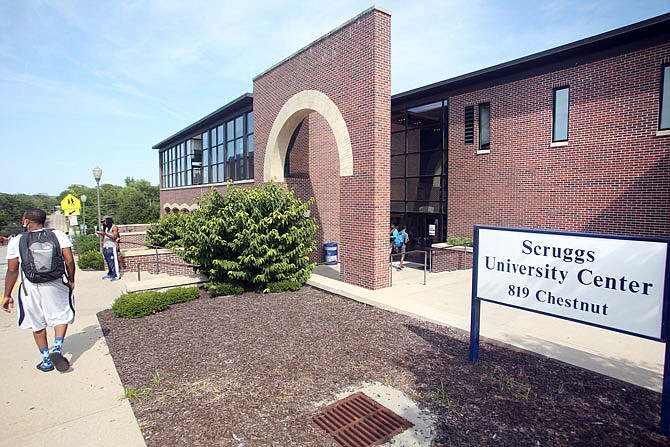Lincoln University’s new automatic scholarship framework won’t start doling out funds until the fall, but officials said it’s already having an impact.
Lincoln announced last October it was reorganizing its scholarship structure to provide more clarity in student eligibility and equity in access. The matrix developed to determine scholarship awards has been marketed to prospective students for the past seven months.
“We are getting more interest, we’re getting more detailed questions and our expectations are that we will be able to have a positive impact on enrollment trends sooner than a lot of people thought, quite frankly,” said Darius Watson, interim dean of enrollment management.
Watson said the purpose of creating the new Blue Tiger Advantage Scholarships was two-fold: help more students afford an education without crushing debt and boost student enrollment.
Blue Tiger Advantage Scholarships are automatically applied to student accounts their freshmen year and the amount a student can receive varies by GPA and standardized testing scores, such as the SAT or ACT. Award amounts range from $500 to $3,250 per semester and are renewable for up to eight semesters.
The automatic scholarship structure takes effect this fall and replaces previous institutional scholarships, which Watson said were applied more broadly and didn’t have an efficient impact on student financial needs.
“The goal here is to make sure that all first-time entering freshmen are given an opportunity to engage financial assistance from the very start,” Watson said.
And that start is before students are even enrolled.
The new structure equips admissions staff with the ability to tell students upon first meeting that they will receive money to attend Lincoln and the amount they receive depends on their final year of high school, Watson said.
“That in and of itself is attractive in the sense that it’s an automatic thing, and it’s available to all incoming, first-time freshmen,” he said.
Preliminary numbers indicate it could be having a positive impact on admissions.
Lincoln’s enrollment has been declining for the past decade, reaching a low of 1,793 undergraduate and graduate students last fall.
“I believe our trend lines are above where they were at this time last year,” Watson said of upcoming fall enrollment figures. “There does seem to be a potential for improvement from both an admitted students and enrolled students perspective — just because we admit them all, doesn’t mean they’re all coming.”
Nearly 1,300 students have been admitted to Lincoln for the fall semester so far and more than 500 — or about 40 percent — would receive a Blue Tiger Advantage Scholarship of some amount, Watson said.
He said he doesn’t have an approximate number of Lincoln students who currently receive scholarships, but more than 90 percent get some form of financial assistance in the form of scholarships, grants or loans.
Watson said the full implementation of Blue Tiger Advantage Scholarships this fall should produce a clear idea of how many students are attending on scholarships.
“We’re trying to turn a rather big boat rather quickly, but I think we’re achieving some success in those areas,” Watson said. “But, again, we won’t know until we do our census in the fall.”
In addition to aiding recruitment efforts, Watson said the Blue Tiger Advantage Scholarship structure is helping the university standardize scholarship processes and awards across departments.
“We have several different pathways through which a student can potentially get scholarship money at the university and in the past we tended to have them somewhat siloed,” he said.
Internally, Lincoln offers the Blue Tiger Advantage Scholarship, athletic scholarships and select scholarships for students of band, ROTC and agriculture. There are less than a dozen sources for internal scholarships at Lincoln, Watson said.
But the university also offers secondary level scholarships that are often specific to individual departments and it promotes a tertiary level of external scholarships. Students also bring in scholarships they were awarded elsewhere, Watson added.
A majority of full ride scholarships come from secondary or tertiary areas, Watson explained, such as the 1890 David Scott Full Ride Scholarship that is supported by the U.S. Department of Agriculture for agriculture students.
The top tier of the Blue Tiger Advantage Scholarship isn’t a full ride with $3,250 awarded per semester and a discounted rate for on-campus housing.
Lincoln charges a flat rate tuition for full-time students taking between 12-18 credit hours per semester and different rates depending on the campus housing that is chosen. Tuition, fees, and room and board, all of which the university increased in April, averages around $8,097 per semester for Missouri students and $11,712 for out-of-state students.
Watson said he doesn’t credit the turning enrollment tide entirely to the new scholarship structure. The university is working on a number of articulation agreements with community colleges and schools around the country and could potentially develop a new scholarship structure for transfer students as well.
“We are working overtime to improve everything that is Lincoln University and part of that is improving financial frameworks, supports and foundations, and we’re pretty confident the Blue Tiger Advantage Scholarship is really a solid start to that,” Watson said.

